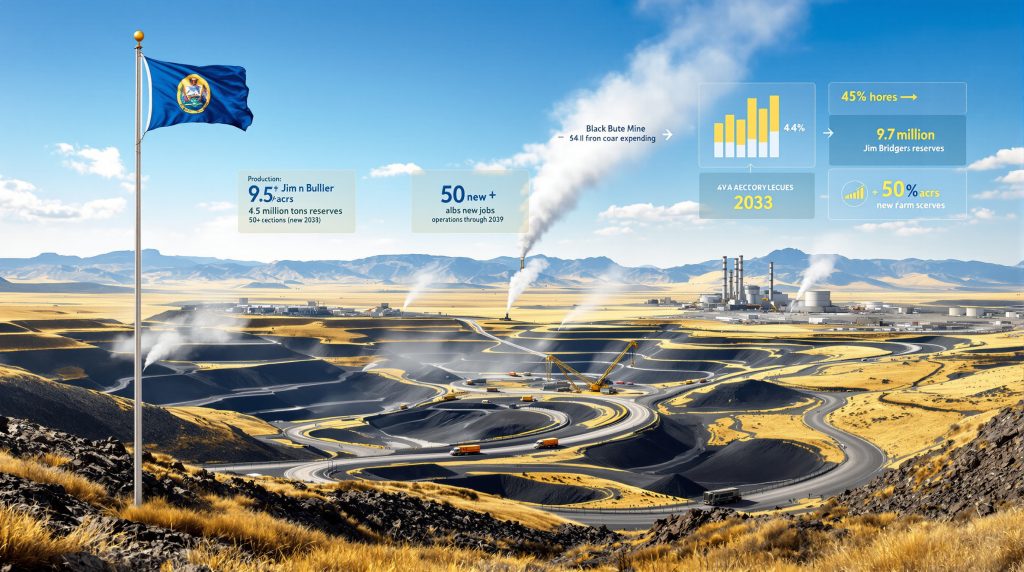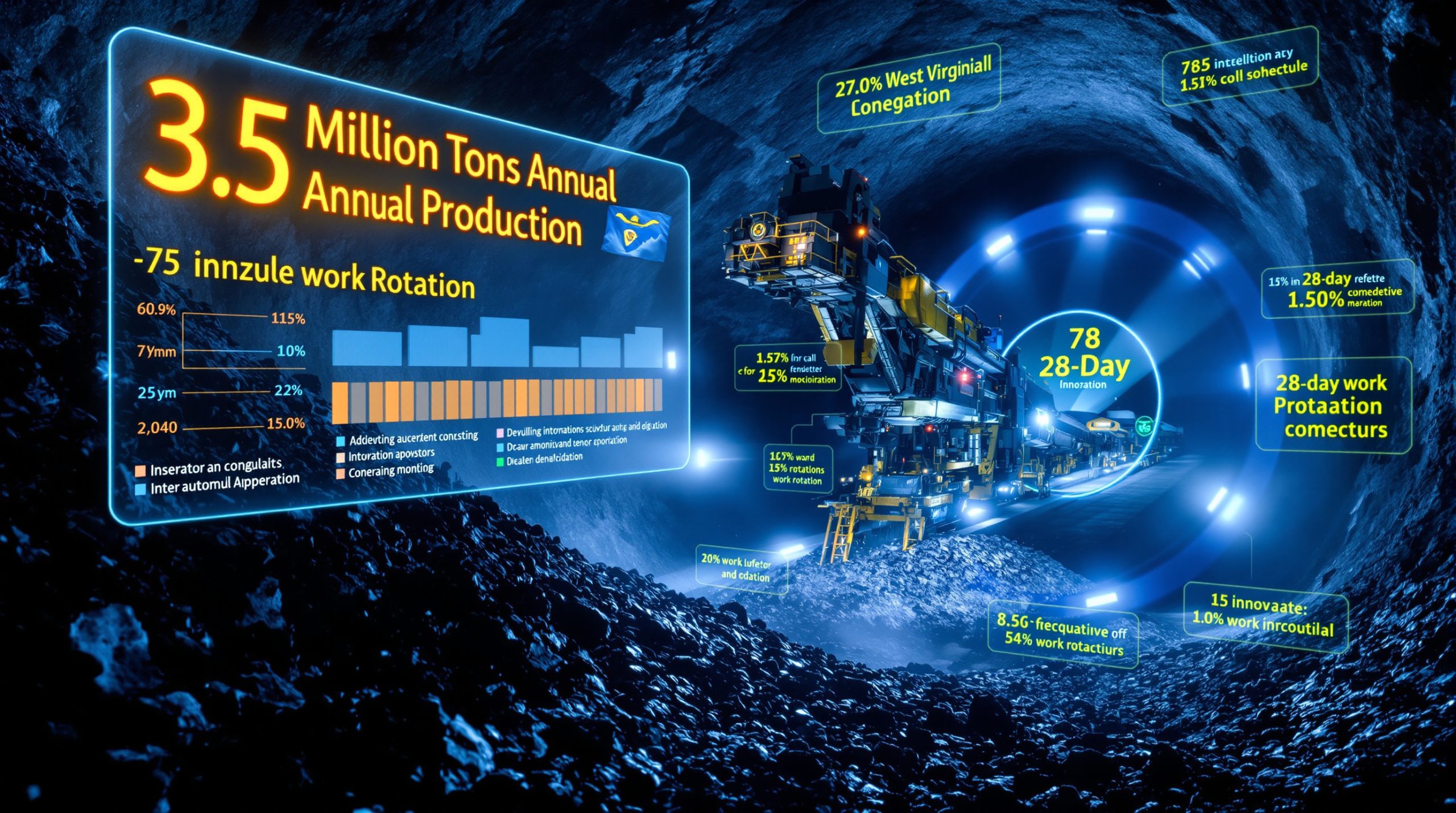Understanding Wyoming's Strategic Coal Mining Development
The Wyoming Black Butte mine expansion represents a pivotal development in American energy infrastructure, securing federal approval to extract 9.2 million tons of coal reserves from designated areas known as Pit 15 and Pit 10. Located in Sweetwater County within Wyoming's Green River Basin, this operation has maintained continuous production since 1977, establishing itself as a cornerstone of regional energy supply.
Federal authorities expedited the approval process through streamlined National Environmental Policy Act procedures, demonstrating the current administration's commitment to domestic energy development. The expansion encompasses surface mining operations designed to maximise resource recovery while implementing comprehensive environmental stewardship protocols.
Geographic and Operational Scope
The Black Butte mine operates within Wyoming's sub-bituminous coal region, where favourable geological conditions enable efficient surface extraction methods. These coal deposits feature low sulphur content ranging from 0.2% to 0.8%, significantly below eastern coal varieties that typically contain 1% to 3% sulphur. This characteristic makes Wyoming coal particularly valuable for power generation applications requiring cleaner-burning fuel sources.
Surface mining operations in this region benefit from low stripping ratios of 2:1 to 6:1, meaning relatively small amounts of overburden must be removed to access coal seams. This compares favourably to Appalachian operations that often require removing 15 to 25 cubic yards of material per ton of coal extracted.
Timeline and Production Projections
Mining operations under the expanded framework will continue through 2039, extending the mine's productive lifespan by nearly two decades. The approval enables systematic extraction from previously inaccessible federal coal deposits, utilising proven mining methodologies refined over the facility's 48-year operational history.
Production planning incorporates modern resource management techniques that optimise extraction efficiency while maintaining environmental compliance standards. Furthermore, these techniques reflect broader industry evolution trends that emphasise technological advancement in mining operations. The mine's strategic location within established transportation networks ensures reliable coal delivery to regional power generation facilities.
Job Creation and Economic Development Opportunities
The expansion will generate more than 50 additional employment positions, representing an 89% increase from the current workforce of 56 full-time employees. This employment growth extends beyond direct mining positions to encompass specialised roles in equipment operation, environmental monitoring, safety management, and technical support services.
Wyoming's coal mining industry maintains the highest per-capita mining employment among U.S. states, with approximately 6,000 workers employed directly in coal extraction operations statewide. The average annual wage for coal mining positions in Wyoming reaches $92,000, significantly exceeding regional median incomes and providing substantial economic benefits to local communities.
Skills and Training Requirements
Modern surface mining operations demand specialised expertise in advanced equipment operation, including:
- Ultra-class haul trucks with 240-400 ton capacity
- Electric rope shovels and hydraulic excavators
- Automated material handling systems
- Environmental monitoring technologies
- Safety and emergency response protocols
Training programmes align with Mine Safety and Health Administration requirements, emphasising equipment proficiency, hazard recognition, and environmental compliance procedures. Workers receive comprehensive instruction in collision avoidance systems, fatigue monitoring protocols, and emergency communication procedures.
Regional Economic Multiplier Effects
Economic research indicates that each mining position supports approximately 3.3 additional jobs in the broader regional economy, according to National Mining Association analysis. These indirect positions span transportation services, equipment maintenance, supply chain management, and local retail sectors.
The expanded workforce will generate an estimated $4.6 million in additional annual wages, based on average Wyoming coal mining compensation levels. This income circulates through local economies, supporting businesses and services throughout Sweetwater County and surrounding areas.
Federal Approval Mechanisms and Environmental Review
The Department of Interior utilised alternative arrangements under the National Environmental Policy Act to expedite project approval while maintaining comprehensive environmental assessment standards. This streamlined approach reflects current federal energy policy priorities emphasising domestic resource development and reduced regulatory timelines.
The Office of Surface Mining Reclamation and Enforcement completed environmental review procedures in significantly reduced timeframes compared to standard processes that typically require 12 to 24 months for Environmental Impact Statements. Alternative arrangements can reduce approval timelines by 40% to 60% while preserving environmental protection requirements.
Public Engagement and Comment Periods
The regulatory framework included a 10-day public comment period and virtual public meeting, providing community input opportunities within an accelerated timeline. This approach balanced stakeholder engagement with efficient project progression, ensuring local concerns received consideration during the approval process.
Virtual meeting formats expanded participation accessibility, enabling broader community involvement regardless of geographic constraints or scheduling limitations. Digital engagement platforms facilitated comprehensive information sharing and responsive dialogue between federal agencies and local stakeholders. For instance, federal officials highlighted the importance of maintaining Wyoming's mining industry leadership in national energy production.
Environmental Stewardship Requirements
Federal approval mandates comprehensive land restoration following extraction completion, requiring operators to restore mined areas to original contours or approved alternative configurations. The Surface Mining Control and Reclamation Act establishes specific reclamation standards including:
- Topsoil replacement depth: minimum 48 inches
- Revegetation requirements: native species achieving 90% ground cover within 10 years
- Grading specifications: approximating original landscape contours
- Long-term monitoring: ongoing assessment of restoration success
Wyoming has successfully reclaimed over 200,000 acres of previously mined land since 1977, demonstrating proven capability in post-mining landscape restoration within challenging semi-arid environmental conditions. Additionally, mine reclamation innovation continues to enhance restoration techniques across the industry.
Primary Energy Infrastructure Connections
The Jim Bridger Power Plant serves as the exclusive recipient of coal production from Black Butte mining operations, creating an integrated energy supply system that has operated reliably for nearly five decades. This 2,120-megawatt facility comprises four coal-fired generating units, each rated at 530 megawatts capacity.
Operated by PacifiCorp, a subsidiary of Berkshire Hathaway Energy, the Jim Bridger facility provides electricity to approximately 2 million customers across six western states: Utah, Wyoming, Idaho, Oregon, Washington, and California. Annual coal consumption reaches 5 to 6 million tons from multiple regional suppliers.
Energy Security and Grid Reliability
Coal-fired generation provides essential baseload power capacity, operating at consistent output levels regardless of weather conditions or time of day. This reliability supports Western Interconnection grid stability during peak demand periods and seasonal variations in renewable energy production.
Wyoming coal plants generated approximately 28,000 gigawatt-hours of electricity during 2024, representing significant regional generation capacity. Coal-fired facilities typically achieve capacity factors between 40% and 75%, providing dependable electricity supply when grid demand fluctuations require consistent baseload support.
Transportation and Logistics Networks
Black Butte mine utilises truck transportation to deliver coal approximately 30 miles to the Jim Bridger Power Plant, minimising transportation costs and delivery timeframes. Established haul routes connect mining operations to generation facilities through dedicated transportation infrastructure designed for heavy industrial loads.
This integrated logistics system ensures efficient coal delivery while reducing transportation-related environmental impacts compared to longer-distance rail or barge transportation methods. Direct mine-to-plant delivery eliminates intermediate handling and storage requirements.
Strategic Energy Independence Objectives
The Wyoming Black Butte mine expansion aligns directly with federal energy dominance strategies emphasising domestic resource development and reduced dependence on energy imports. Secretary of the Interior Doug Burgum characterised the approval as strengthening national Energy Dominance through responsible federal coal resource utilisation.
Federal coal production from public lands totaled approximately 250 million tons during 2024, representing significant domestic energy resource contributions. Wyoming accounts for roughly 42% of total U.S. coal production, maintaining its position as the nation's leading coal-producing state since 1988.
Energy Dominance Framework
Current federal energy policy emphasises maximising domestic production across multiple energy sources while maintaining market competitiveness and environmental responsibility. Coal extraction from federal lands generates substantial revenues through the federal coal leasing programme, contributing approximately $165 million annually to Wyoming through mineral royalty distributions.
The Bureau of Land Management manages coal leasing on federal lands, with Wyoming containing approximately 40% of all federally-owned coal reserves. Federal coal royalty rates of 12.5% for surface-mined coal generate significant federal revenues while supporting state and local economic development.
Regional Energy Infrastructure Development
Wyoming's strategic position as America's premier energy-producing state benefits from continued investment in coal extraction capabilities and transportation infrastructure. The state's energy sector represents approximately 20% of Wyoming's gross domestic product, supporting broader economic diversification efforts.
Coal mining operations contribute substantially to state revenues through severance taxes totaling approximately $635 million in 2023, supporting educational funding, infrastructure development, and public services throughout Wyoming. However, the industry is increasingly adopting sustainable mining practices to balance economic needs with environmental responsibility.
Comprehensive Environmental Management Protocols
Modern coal mining operations incorporate sophisticated environmental protection systems addressing air quality management, water resource conservation, wildlife habitat preservation, and soil conservation throughout extraction processes. These protocols exceed minimum regulatory requirements through voluntary implementation of enhanced environmental stewardship practices.
The semi-arid climate conditions in Sweetwater County present unique environmental challenges, including limited precipitation averaging 7 to 10 inches annually and growing seasons spanning only 60 to 90 days. These conditions require specialised revegetation techniques utilising drought-resistant native plant species.
What Are the Key Restoration and Reclamation Requirements?
Comprehensive restoration planning addresses post-mining land use through detailed vegetation restoration, soil rehabilitation, and habitat reconstruction programmes. Surface Mining Control and Reclamation Act requirements mandate returning mined areas to original productivity levels or achieving approved alternative land uses.
Reclamation success in Wyoming's challenging environmental conditions requires:
- Soil Management: Preserving and replacing topsoil layers to maintain fertility
- Species Selection: Utilising native plants adapted to local climate conditions
- Water Management: Implementing moisture retention techniques for vegetation establishment
- Monitoring Programmes: Long-term assessment of restoration effectiveness
Monitoring and Compliance Systems
Ongoing environmental monitoring ensures continuous compliance with federal and state regulations throughout mining operations. Regular assessments track multiple environmental parameters including air quality measurements, surface and groundwater monitoring, vegetation establishment success, and wildlife habitat conditions.
Advanced monitoring technologies enable real-time data collection and analysis, supporting proactive environmental management decisions. These systems facilitate early detection of potential environmental concerns, enabling rapid corrective actions when necessary.
Advanced Mining Technology Integration
Contemporary surface coal mining utilises sophisticated equipment and operational systems designed to maximise extraction efficiency while minimising environmental impacts. Black Butte operations incorporate proven technologies refined through decades of mining industry innovation and safety advancement.
Modern surface mining equipment includes ultra-class haul trucks capable of transporting 240 to 400 tons per load, electric rope shovels with rapid cycle times, and hydraulic excavators providing precise material handling. Consequently, AI mining innovations are increasingly integrated into these systems to optimise performance. These systems operate under comprehensive safety protocols including collision avoidance radar, proximity detection systems, and continuous atmospheric monitoring.
Safety and Operational Efficiency Systems
Mining operations prioritise worker safety through integrated technology systems and comprehensive training programmes. Safety technologies include:
- Proximity Detection: Radar-based collision avoidance systems
- Fatigue Monitoring: Operator alertness assessment technologies
- Communication Systems: GPS tracking and emergency response networks
- Atmospheric Monitoring: Continuous gas detection and air quality assessment
These systems contribute to Wyoming's coal mining safety record, which consistently exceeds national mining safety averages through proactive hazard identification and risk mitigation strategies.
Data Analytics and Resource Optimisation
Advanced data collection systems optimise extraction patterns, equipment utilisation schedules, and resource recovery rates through real-time operational analysis. These technologies support informed decision-making throughout mining processes, maximising operational efficiency while maintaining environmental compliance.
Modern mining operations generate extensive data streams from equipment sensors, environmental monitors, and production systems. Analytics platforms process this information to identify optimisation opportunities and predict maintenance requirements through sophisticated data-driven operations.
Wyoming's Position in National Coal Production
Wyoming consistently maintains its position as America's leading coal-producing state, generating approximately 244 million tons during 2024 despite overall industry production declines. This represents roughly 42% of total U.S. coal production, demonstrating the state's continued dominance in national energy supply chains.
Wyoming Coal Production Leadership (2024):
| State | Production (Million Tons) | National Percentage |
|---|---|---|
| Wyoming | 244 | 42% |
| West Virginia | 83 | 14% |
| Pennsylvania | 38 | 7% |
| Illinois | 36 | 6% |
| Montana | 33 | 6% |
Production Capacity and Market Position
Wyoming's coal industry benefits from exceptional geological advantages including thick coal seams spanning 50 to 100 feet in the Powder River Basin, compared to Appalachian seams averaging 3 to 10 feet thickness. These favourable conditions enable highly efficient surface mining operations with minimal environmental disruption.
The state's sub-bituminous coal features heat content ranging from 8,400 to 8,800 BTU per pound, while maintaining extremely low sulphur content between 0.2% and 0.8%. This combination provides cleaner-burning characteristics compared to higher-sulphur eastern coals.
Competitive Advantages and Market Factors
Wyoming coal operations maintain significant competitive advantages through:
- Low Production Costs: $12-18 per ton versus $45-65 for Appalachian underground mining
- Surface Mining Methods: 100% surface extraction eliminating underground operation complexities
- Transportation Networks: Established rail and trucking infrastructure to major markets
- Reserve Base: 68.1 billion tons of demonstrated reserves, representing 40% of U.S. total
These advantages support Wyoming's continued market leadership despite overall coal industry transitions toward alternative energy sources.
Comprehensive Economic Contributions Analysis
Coal mining generates substantial economic benefits for Wyoming through direct employment compensation, state tax revenues, federal royalty payments, and supporting industry development. These contributions support essential government services while maintaining regional economic stability in rural communities.
Wyoming's coal industry provides approximately $550 million in annual direct wages, with average mining salaries of $92,000 significantly exceeding regional median incomes. Total industry economic contribution reaches an estimated $3.2 billion annually when including indirect and induced economic effects.
Revenue Generation and Tax Contributions
Coal mining operations contribute multiple revenue streams supporting state and local government operations:
State Revenue Sources:
- Severance Tax: 7% of gross production value generating ~$635 million (2023)
- Property Tax: Based on assessed value of mining property and equipment
- Sales Tax: Equipment purchases and operational expenditures
Federal Revenue Sharing:
- Mineral Royalties: 12.5% of production value with 50% distributed to Wyoming (~$165 million annually)
- Lease Bonus Payments: One-time payments for federal lease acquisitions
- Coal Lease Bonus Payments: Competitive bidding generates additional federal revenues
Supply Chain and Supporting Industries
Mining operations support extensive regional supply chains including equipment manufacturing, transportation services, maintenance contractors, and technical consulting services. These interconnected industries create additional employment opportunities and economic activity extending far beyond direct mining operations.
Supporting industries benefit from mining operations through:
- Equipment Supply: Heavy machinery, replacement parts, and specialised tools
- Transportation Services: Rail, trucking, and logistics coordination
- Professional Services: Engineering, environmental consulting, and legal services
- Local Businesses: Retail, hospitality, and personal services in mining communities
Long-term Strategic Planning and Development Initiatives
Wyoming's coal industry continues evolving through technological advancement, market adaptation, and strategic planning initiatives addressing changing national energy markets and environmental regulations. Future developments focus on maintaining competitive advantages while exploring emerging opportunities in carbon utilisation and export markets.
Industry stakeholders recognise the need for diversification strategies that leverage existing mining expertise and infrastructure investments. These approaches include developing carbon capture technologies, exploring international export opportunities, and investigating alternative coal applications beyond traditional electricity generation.
Technology Innovation and Efficiency Improvements
Ongoing research initiatives target improved extraction efficiency, enhanced environmental protection, and advanced safety protocols through collaborative industry development programmes. These innovations support long-term sustainability while maintaining Wyoming's competitive position in national energy markets.
Technology development priorities include:
- Autonomous Equipment: Reducing operational costs and improving safety through unmanned systems
- Environmental Monitoring: Enhanced real-time assessment capabilities
- Carbon Utilisation: Developing commercial applications for coal-derived carbon products
- Reclamation Technology: Improved restoration techniques for challenging environmental conditions
Market Diversification and Export Opportunities
Strategic planning encompasses developing international export markets, particularly in Asia where coal demand continues growing. Wyoming's low-sulphur coal characteristics provide competitive advantages in export markets requiring cleaner-burning fuel sources. In addition, analysts have noted the strategic importance of Wyoming coal exports in global energy markets.
Export development faces infrastructure challenges including transportation capacity limitations and port facility requirements. However, potential international demand creates opportunities for sustained Wyoming coal production despite domestic market transitions.
The Wyoming Black Butte mine expansion represents a strategic investment in America's energy independence while supporting regional economic development through job creation and infrastructure investment.
Disclaimer: This article contains forward-looking statements regarding coal mining operations, employment projections, and market conditions that involve inherent uncertainties and risks. Actual results may differ materially from projected outcomes due to market fluctuations, regulatory changes, environmental factors, and other variables beyond operator control. Investment and employment decisions should be based on comprehensive analysis of current market conditions and individual circumstances.
Looking to Capitalise on Mining and Energy Investment Opportunities?
Discovery Alert's proprietary Discovery IQ model delivers real-time alerts on significant ASX mineral discoveries, instantly empowering subscribers to identify actionable opportunities ahead of the broader market. Begin your 30-day free trial today at Discovery Alert and secure your market-leading advantage in the dynamic mining sector.




